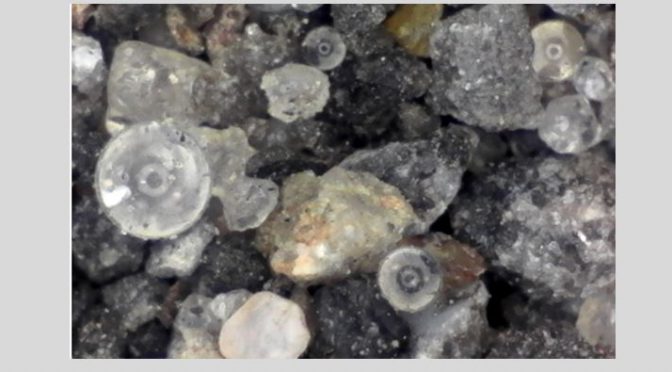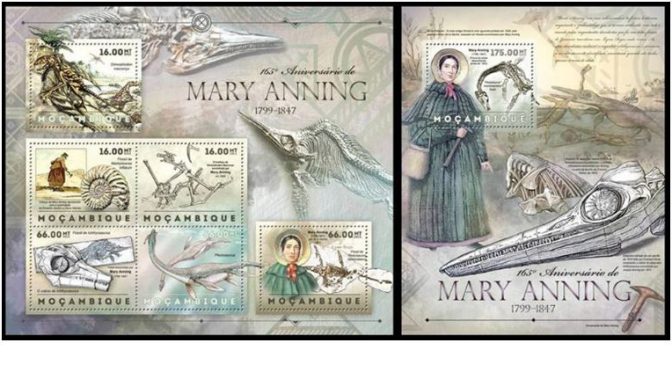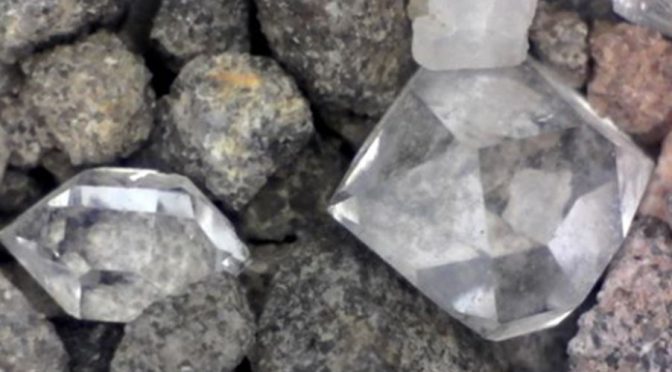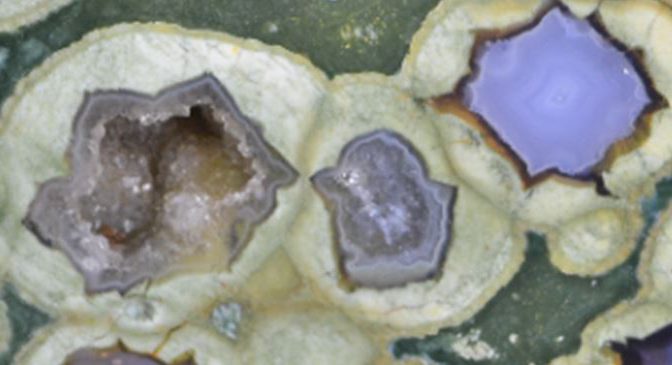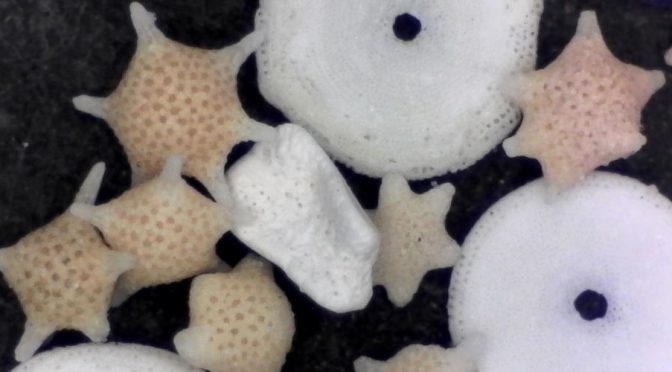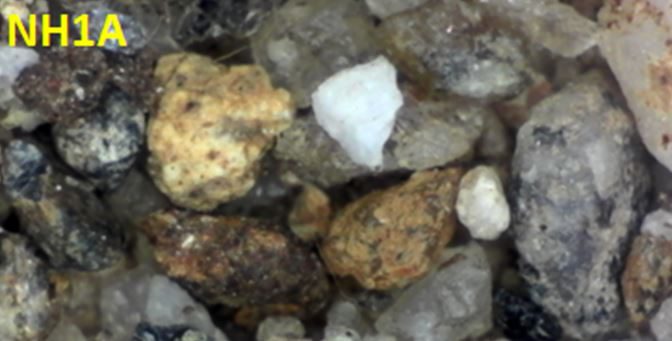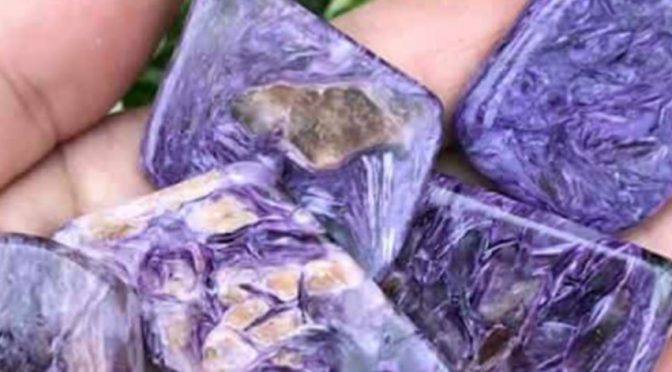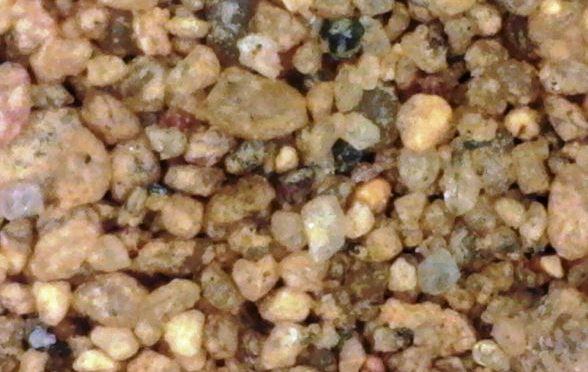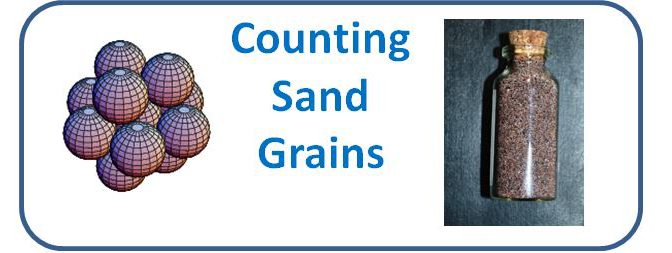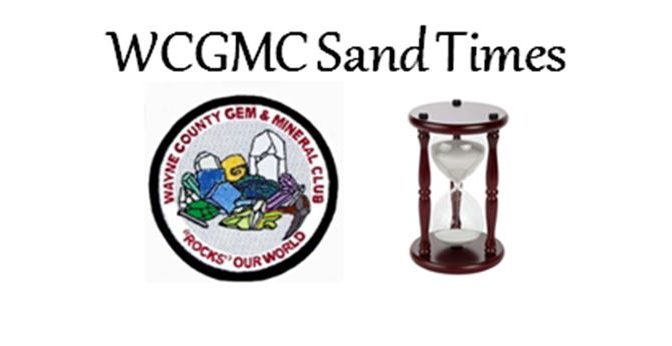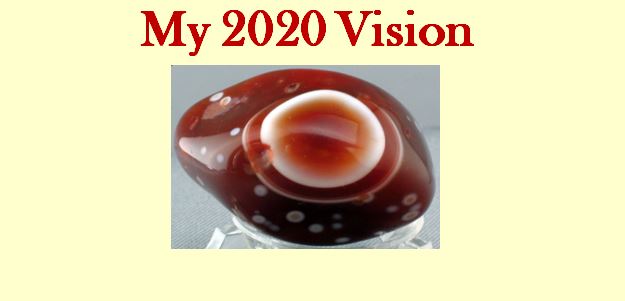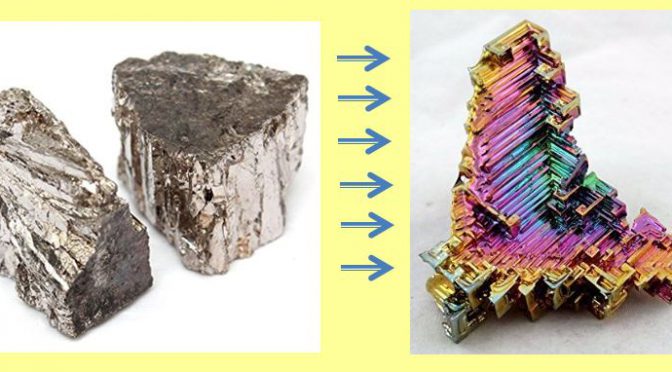While I was piling up steps on my Health App, I was also thinking about all those good sands I was missing by not traveling about the northeast (or even beyond). And one fine day, I decided to drop into a small creek that crosses East Ave just north of Pittsford and sample sand that was visible through all the new growth. I knew it would not be spectacular, but it did look like a nice sand bar had developed just off the road where the creek made a sharp jog. And heck, why not?
All posts by Fred Haynes
My First Sand?
It has now been almost a year since I started actively collecting and trading sand. I collected somewhere near 100 different sands last summer and fall during mineral trips or on day outings around western New York. And during the winter I have traded some of those for others. I think my total count exceeded 750 earlier this month when trade packages arrived from Maryland and California.
With that backdrop, imagine my surprise last January when my wife dug out three peanut butter jars from the corner of the garage labeled “Monahans Sandhills, 1995”. They were full of tan quartz-dominated sand! She had collected the quartz-rich sand when we had lived in Midland, Texas, some 50 miles to the east. She had earmarked them for our three sons and pretty much forgotten them (the sands, not our sons!).
Ancient Glacial Loess
The global pandemic has all of us re-thinking our daily lives. I had to cancel (or at best postpone) a May trip to collect sands from New England beaches. With my time at home, I chose to walk about my neighborhood. While doing this I was always alert to opportunities to collect sand. They would certainly not be as exotic as Cape Cod or the creeks in the Berkshires of western MA, but perhaps they could still be interesting.
One location I wanted to sample was in a small town park close to my home which contained a nice half-mile trail through the woods. My home sits atop glacial lake sediments (or dunes created when the glacial lake emptied). I have dug for fine sand there (Sand Times, vol 1 #1, pg. 2). The surface geology map of western NY suggests this park might be outside the lake boundaries. Might the sand there be different? Continue reading Ancient Glacial Loess
Mary Anning
I am a member of the Rochester Academy of Science Fossil Section. In last month’s newsletter (called the Fossiletter), Michael Greiner wrote a wonderful biographic note on Mary Anning touching aspects of her professional accomplishments and her personal life. Mary was an early 19th century paleontologist in England who is credited with discovering and describing several Cretaceous marine reptiles including Plesiosaurus and Ichthyosaurus. I enjoyed learning about her fascinating contributions to paleontology.
After reading the full article I wondered if Mary Anning had ever been commemorated on a postage stamp. Yes, I collect postage stamps with a thematic specialty of geology on stamps. This includes minerals, fossils, dinosaurs, volcanoes, and yes, famous geologists. I was not aware of any Mary Anning stamps, but I did know where to look for them. And I found a few.
Collecting Garnets
The spring of 2020 was not a time for collecting and it appears the summer may not be much better. But that does not preclude me from reminiscing about a few past trips and finds. And I have decided to do that with a focus. I am going to think about all the places that I have been with Wayne County Gem and Mineral Club where garnets could be collected. Not only is this club “always looking for places to dig”, but they are pretty darn good at finding them.
Golf Course Sand
It is mid-April and I should be planning field trips, perhaps even taking my first of the season. But like everyone else I am planted at home, watching the first responders and others attempting to defeat this virus. But what else have I been doing? Well, first off, the yard and all the rock gardens may look as good as they ever have by the time it is warm enough for growth to begin. And I have been taking walks, lots of walks: short walks, intermediate walks, and long walks. I am wearing my walking shoes out. I know every nook and cranny of my neighborhood.
On one of those long walks in late March, I was thinking about the New England beach trip for sand collecting that I was not going to be able to undertake. And I happened to be walking along the edge of Oak Hill Golf Course in my home town of Pittsford, NY. I saw sand, lots of sand. Of course, I know that golf course sand is not local, nor is it 100% natural. Nevertheless, I did wonder what it looked like and where it might come from.
It Was Meant To Be
I should have known. It was only a matter of time before I would return to my roots and become a sand collector again. It goes back to December of 1976. I was a senior at Lehigh University with one semester left before earning a B.S. in Geology. I wanted to do a Senior Research project during my final semester. Having just completed a course in Sedimentology, Professor Bobb Carson suggested I study the heavy minerals present in beach sand. Perhaps I could compare the composition of heavy minerals present in the tidal zone with those high in the dunes. Perhaps aeolian sands would have a different heavy mineral content than those in the tidal zone. Why not, I thought. It could be fun.
Herkimer sand
On April 1st, Wayne County Gem and Mineral Club was planning to open its 2020 field season with a visit to Ace of Diamonds in Middleville, NY. The coronavirus has intervened with our plans and this annual rite of passage is not possible this year, but we can spend time enjoying the Herkimers we have collected on past trips.
For most folks these are small- or modest-sized crystals collected from the piles of rock the owners have hauled from their active, off-limits, mining area behind the hill. And I certainly spend time digging and breaking large rocks in search of centimeter or inch-sized diamonds. But, when the club visited last October, just before the site went into its annual hibernation, I did something a bit different.
Blue Sand from California
Sand comes in virtually all colors, however, as my collection grew this past year, I was not adding much blue to my collection. In fact, I really did not have a blue sand until a very unique and interesting sand appeared in the trade box that Bill Beiriger sent me in January. It was inauspiciously labeled as fine, blue-gray sand from a location 12 miles east of Livermore, California. The GPS coordinates Bill provided placed the site closer to Tracy, California and in the Diablo Mountain foothills.
Bowling Ball Beach
Given the travel restrictions surrounding the coronavirus , it is not possible to do much field planning yet this year, but that does not mean we cannot take some virtual trips. For starters, I found an interesting beach with some neat geology. Bowling Ball Beach is in northern California and there are huge concretions scattered along the Pacific Ocean shoreline. They call them bowling balls, but they look more like small moons to me. I decided to learn more about them.
Rain Forest Jasper
Each month at the Wayne County Gem and Mineral Club Saturday club workshop our President (who doubles as our Collection Curator) brings along something from the club collection to raffle off to all who attend the workshop. This month she arrived with a superb spread of unpolished slabs of Rain Forest Jasper, a very specific form of jasper from the Mt. Hay volcanic field in central Queensland, Australia.
The Sands of Guam
This winter I have been an active sand trader, acquiring sand from around the world in exchange for some I collected on our club trips last summer. I could fill a book with stories and pictures of these sands and their locations. However, for now, I have selected one location and two sands to highlight. But first, a little history and a bit of geology.
Bumpus Brook Sand
It seems many sand collections focus on ocean beaches. This is understandable. The settings provide gorgeous destinations and the sands can be wonderfully textured. I like beach sands, but don’t want to short-change river sands in my collection. Unlike beaches, where provenance is hard, or even impossible, to define, river sands offer an interesting opportunity as their provenance can be determined. Naturally, this is not easy if your sample comes from the Mississippi River delta but consider the other extreme, a sand sample from a mountain stream.
Last July, I traversed the White Mountains of northern New Hampshire on a return trip from Maine. Just off Route 2 north of the Presidential Range is a short, 3 mile (5 kilometers) drainage between two ridges on the steep north slope of Mt. Madison. It is called Bumpus Brook and a small bridge along Pinkham B Road allows access. Much of the creek’s sediment load is larger than sand size with cobbles and small boulders strewn along the flowing stream. But, at bends on both sides of the bridge, there are sand bars that can be sampled.
Charoite
Who likes purple minerals? It seems just about everyone likes purple minerals and there will be a few choice ones at the Wayne Country Gem and Mineral Club auction on February 14th. Yes, the auction this year is on Valentine’s Day. Someone is going to go home with a brilliant amethyst piece, but you will have to come to the auction to see how purple it is and whether it is from Brazil or Uruguay. There might also be lepidolite or bismuth or fluorite or other purple goodies.
But this note is going to focus on another purple favorite. Almost every month someone arrives at the workshop with a small slice of purple charoite. The color captures the eye first, but the mesmerizing swirling pattern of the bands of charoite is irresistible if not a bit hypnotic.
My Backyard Sand
About 12,000 years ago, pro-glacial Lake Iroquois occupied all of the current Lake Ontario and extended significantly south and east into New York. The glacial ice was retreating but had not yet melted far enough north to expose the St. Lawrence Seaway, forcing the significantly larger Lake Iroquois to drain east through the Mohawk Valley and then south along the Hudson River. All of Rochester, NY was beneath this lake.
Counting Sand Grains
Did you ever wonder how many grains of sand were on a beach? Or perhaps the simpler question of how many grains of sand fit into a 20 ml collecting vial like the one in the cover photo? I imagine you probably have not, but I did.
New WCGMC Newsletter
The Wayne Country Gem and Mineral Club has moved into the sand business! Well, I guess you could say we’ve come to the realization that sand grains are minerals and since we collect minerals, well, perhaps we should collect sands. I guess I fell for the “sport” and then for the documentation part, a new newsletter. Below is the opening article introducing the newsletter and our mission. And here is a link to the full newsletter (WCGMC Sand Times Vol. 1, no. 1)
This is the inaugural issue of a newsletter published by the Sand Section of the Wayne County Gem and Mineral Club. In 2019, one of us, Jim Rienhardt, introduced the club to a new aspect of “mineral” collector by sharing a collection of sands and talking about the hobby. A few members took interest and decided to give the hobby a try. The other of us, Fred Haynes, fell for the challenge of collecting and understanding sands hook, line and sinker.
Color of the Year
Each December, The Pantone Color Institute announces its “Color of The Year” for the coming twelve months. Everyone from furniture makers to jewelry designers to car companies, and, I suppose, to mineral dealers, takes notice as they plan their upcoming year products.
The Pantone Color of the year for 2020 is Classic Blue. In making this announcement on December 11th, Pantone describes Classic Blue as “where sky and sea meet” and they suggest that folks who want to sport the 2020 color do so through “accent pieces such as a scarf or a watch strap, or perhaps a vase or candle for your home or office.” This is all well and good, but mineral enthusiasts might want to know what mineral best typifies this choice.
My 2020 Vision
Many people make New Year’s Resolutions. Or perhaps just some people still practice the time old tradition of making personal promises and then breaking them? I am going to forego that doomed-to-fail endeavor this year and replace it with a vision statement. Someone told me Vision Statements are still in vogue. I am going to call it My 2020 Vision and each month (or until I grow tired of the exercise) I will check in to see how well I am maintaining my 2020 Vision.
My 2020 Vision revolves around one word: MORE
Cooking Up Some Bismuth
Lots of folks like minerals. Many of us also like to cook. At the October meeting of the Wayne County Gem and Mineral Club Inga Wells brought native bismuth and her “cooking” equipment and showed us how to cook up some bismuth crystals. Everybody got a close-up look at bismuth stew and then got to take a piece home.
Bismuth (Bi) is a post-transition metal with an atomic number of 83, directly beside lead on the periodic table and below antimony and arsenic. However, unlike arsenic, bismuth is non-toxic and heating to the melting point does not emit dangerous fumes. That said, the silvery-white metal melts at 530⁰ F so you might want to wear gloves and observers should keep at a distance while the crystals grow. Inga told us that stainless steel pots and silverware and a hot plate seem to be the best tools for heating and handling the molten material. It is further recommended that once pots are used with bismuth that they are retired from primary kitchen use! You can also see that Inga wore safety goggles, although not gloves.
